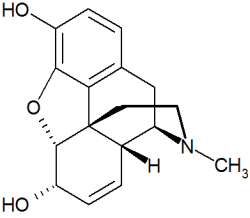Business Editors/Health/Medical Writers
BIOWIRE2K
SAN DIEGO--(BUSINESS WIRE)--Oct. 14, 2003
Ligand's (Nasdaq: LGND) once-daily pain product, AVINZA(R) (morphine sulfate extended-release capsules), provided stable analgesia for one year in patients with chronic back pain, without increases in dose or the use of rescue medicines, according to a long-term clinical study presented in poster form yesterday at the annual meeting of the American Society of Anesthesiologists (ASA) in San Francisco.
In the open-label extension study, independent researchers evaluated the efficacy and safety of AVINZA in 128 patients with chronic, moderate-to-severe back pain who had completed one of four previous AVINZA clinical studies. Since all patients had completed a previous AVINZA trial, the goal in the extension study was to maintain pain control over time. Efficacy was assessed using three measures: changes in pain intensity as measured by patients' Brief Pain Inventory scores, the daily dose of AVINZA, and the number of rescue medicine doses used in the 24 hours before each monthly patient evaluation.
"In this long-term study, patients with chronic, moderate-to-severe back pain who took AVINZA once-daily experienced, on average, stable pain control for the duration of the study, as measured both by the lack of change in pain intensity, and by the stable average dose of AVINZA," said lead author William Keeton, M.D., founder and director of the Dekalb Pain Center in Decatur, Georgia. "In addition, AVINZA maintained pain control while patients used approximately one less dose of rescue medicine per day compared to baseline."
Rescue medicines are drugs such as NSAIDs and short-acting opioids that are used to relieve breakthrough pain.
"With the exception of the improvement observed in the first month, there were no statistically significant or clinically meaningful changes in pain intensity during the one-year study, indicating that AVINZA provided stable, long-term analgesia," Dr. Keeton said.
In the study, the mean daily dose of AVINZA was 184 mg at baseline, 217 mg at six months, and remained stable in months seven through 12. At baseline, patients used an average of 3.2 rescue medicine doses per day. After one month, patient use of rescue medicines fell to an average of 2.0 doses per day, a level that was maintained throughout the study. After 12 months, for example, patients used an average of 1.9 rescue medicine doses per day.
In the study, side effects were similar to those typically observed with opioid therapy, and most were of mild to moderate severity. The most common treatment-related side effects were nausea (20% of patients), constipation (19%) and flu syndrome (14%). No deaths were reported in the study.
According to the authors, lower back pain affects approximately two-thirds of the U.S. adult population, leads to significant increases in physician office visits, and has a significant effect on disability.
About AVINZA
In March 2002, the U.S. Food and Drug Administration granted marketing approval for AVINZA for the once-daily treatment of moderate-to-severe pain in patients who require continuous, around-the-clock opioid therapy for an extended period of time. Ligand launched the product in mid-2002. Organon Pharmaceuticals USA, Inc. began full co-promotion of AVINZA with Ligand in April of 2003.
Full prescribing information for AVINZA may be obtained in the United States from Ligand Professional Services by calling toll free 800-964-5836 or on Ligand's web site at http://www.ligand.com.
About Ligand
Ligand discovers, develops and markets new drugs that address critical unmet medical needs of patients in the areas of cancer, pain, skin diseases, men's and women's hormone-related diseases, osteoporosis, metabolic disorders, and cardiovascular and inflammatory diseases. Ligand's proprietary drug discovery and development programs are based on its leadership position in gene transcription technology, primarily related to Intracellular Receptors (IRs) and Signal Transducers and Activators of Transcription (STATs). For more information, go to http://www.ligand.com.
Caution Regarding Forward-Looking Statements
This news release may contain certain forward-looking statements by Ligand that involve risks and uncertainties and reflect Ligand's judgment as of the date of this release. Actual events or results may differ from Ligand's expectations. For example, there can be no assurance that results of subsequent studies of AVINZA will confirm results presented here, or that patient and physician acceptance of AVINZA will be achieved. Additional information concerning these and other risk factors affecting Ligand's business can be found in prior press releases as well as in Ligand's public periodic filings with the Securities and Exchange Commission, available via Ligand's internet site at www.ligand.com. Ligand disclaims any intent or obligation to update these forward-looking statements beyond the date of this release. This caution is made under the safe harbor provisions of the Private Securities Litigation Reform Act of 1995.
COPYRIGHT 2003 Business Wire
COPYRIGHT 2003 Gale Group



